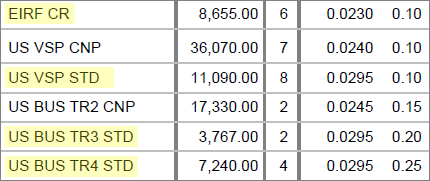Who Needs Interchange Optimization?
Every business benefits from optimal interchange, but some industries are more likely to see downgrades or have opportunities to lower target interchange. Business to business (B2B) companies, businesses that sell to the government, and any business that processes “card-not-present” transactions (such as ecommerce websites and those that key in card information) are particularly likely to have downgrades that can be corrected to lower costs.Interchange and Downgrades
If you’re not familiar with the basics of interchange, you may want to check out our post on credit card processing fees first. Interchange is the component of credit card processing fees that goes to the banks that issue credit cards to consumers. Every time a transaction is processed, it’s routed to an interchange “category” that has a rate and fee assigned. There are hundreds of interchange categories. Below is a snippet of Visa’s interchange table. Every transaction has what we call a “target” interchange category – the category that a transaction will be routed to unless something was done wrong. If everything goes correctly, the transaction will “qualify” for the target category and be charged the rate and fee associated with that category. However, not every transaction qualifies for its target category. When that happens, the transaction “downgrades” to a more expensive category, costing your business more money.
In some cases, you can take specific steps to avoid downgrades. For example, businesses processing card-not-present transactions without using Address Verification Service (AVS) can often fix downgrades by utilizing AVS. These small shifts can help ensure you're receiving the best possible interchange category for your transaction.
Interchange optimization is the process of limiting downgrades to ensure that as many transactions are hitting the “target” category as possible.
But optimization goes beyond simply avoiding downgrades. It’s also about achieving better “target” interchange. This primarily applies to situations like B2B transactions, where you're required to provide additional data to “qualify” for lower cost interchange categories.
Related article: Downgrades at Interchange.
Every transaction has what we call a “target” interchange category – the category that a transaction will be routed to unless something was done wrong. If everything goes correctly, the transaction will “qualify” for the target category and be charged the rate and fee associated with that category. However, not every transaction qualifies for its target category. When that happens, the transaction “downgrades” to a more expensive category, costing your business more money.
In some cases, you can take specific steps to avoid downgrades. For example, businesses processing card-not-present transactions without using Address Verification Service (AVS) can often fix downgrades by utilizing AVS. These small shifts can help ensure you're receiving the best possible interchange category for your transaction.
Interchange optimization is the process of limiting downgrades to ensure that as many transactions are hitting the “target” category as possible.
But optimization goes beyond simply avoiding downgrades. It’s also about achieving better “target” interchange. This primarily applies to situations like B2B transactions, where you're required to provide additional data to “qualify” for lower cost interchange categories.
Related article: Downgrades at Interchange.
There is No “Perfect”
It’s important to note that it’s not usually possible to completely eliminate downgrades; that’s just the nature of processing. Maybe you miss the window for settling a transaction, resulting in a more expensive interchange routing. However, there’s a big difference between a few transactions downgrading and most of your transactions downgrading.




